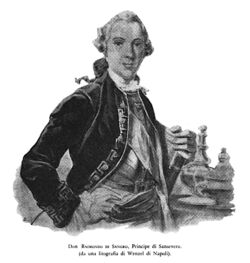Raimondo di Sangro
From Kook Science
| Raimondo di Sangro, 7th Principi di Sansevero | |
|---|---|

| |
| Born | 30 January 1710 Torremaggiore, Regno di Napoli |
| Died | 22 March 1771 (61) Palazzo Sansevero, Napoli, Regno di Napoli |
| Affiliations | Freemasonry |
Raimondo di Sangro (January 30, 1710 - March 22, 1771) was a Neapolitan noble, il Principi di Sansevero, and military leader who engaged in varied scientific and esoteric pursuits, including, infamously, studies in alchemy, mechanics, and anatomy, the two latter two being expressed jointly in his construction of detailed anatomical machines.
Reading
- Peters, Renata; Dacome, Lucia (2007), "Fabricating the Body: the Anatomical Machines of the Prince of Sansevero", AIC Objects Specialty Group Postprints 14, https://www.researchgate.net/publication/266147352_FABRICATING_THE_BODY_THE_ANATOMICAL_MACHINES_OF_THE_PRINCE_OF_SANSEVERO — "The so-called anatomical machines of the Prince of Sansevero, on display at the Museo Capella Sansevero in Naples, are two anatomical models, of a man and a woman, which depict the system of blood vessels in the human body. They were made by the anatomist Giuseppe Salerno in the mid-18th century and presented as the result of anatomical preparations based on a technique known as 'anatomical injection' (injection of embalming substances in cadavers). Sansevero's anatomical machines have gradually become the subject of a legend, according to which the models were the outcome of an operation of human vivisection in which a woman and a man were killed through the injection of embalming substances in their blood vessels. Due to lack of written documentation on the early history of the anatomical machines, controversy continues about how they were actually made. This project tried to address this controversy by combining examination and instrumental analysis of their raw materials and manufacturing techniques with historic research. The conclusions of this study contradict the content of the well-known legend and raise questions about the nature of these objects as products of anatomical injection. More importantly, they also allow the re-telling of the story of the anatomical machines and offer an insight into the world where the legends surrounding Sansevero and the models were originated."